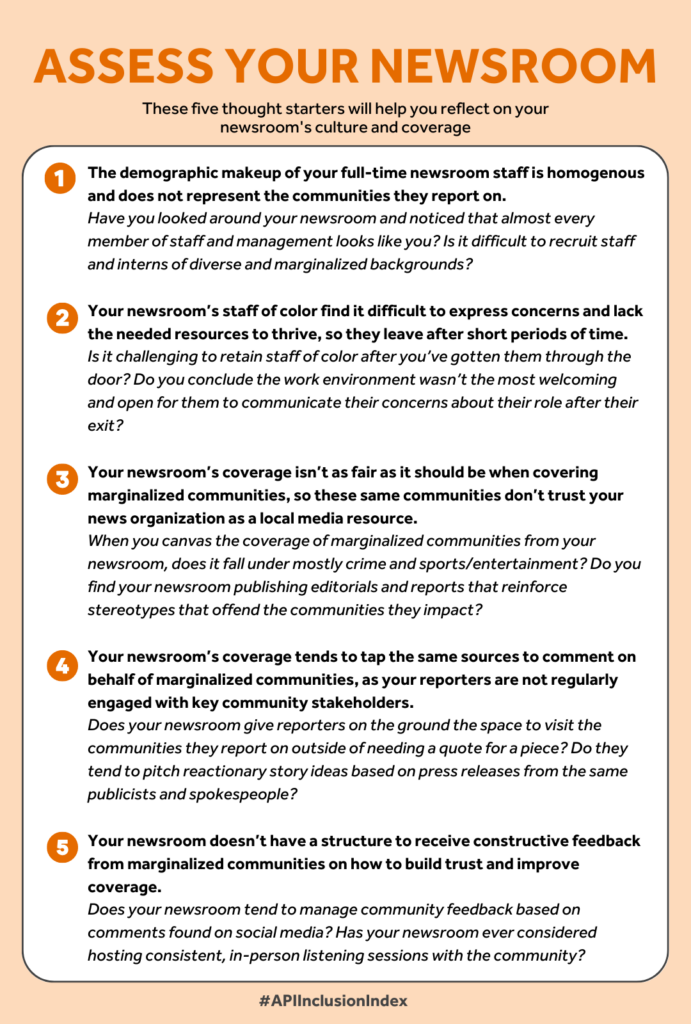In our kickoff of the Inside the Inclusion Index series last week, we gave you an overview of how your newsroom benefits from building a sustainable DEIB plan, and resources on where you can begin to take action — starting with the Inclusion Index rubric. As we continue to highlight our findings from the Pittsburgh news ecosystem, consider the importance of trust in this work.
On a scale from one to five, the Pittsburgh news ecosystem scored a low 1.0 in this area. Residents of color deeply distrust the local media after yearslong, public instances of offensive editorials and columns, mistreatment of reporters of color, racist statements made by local reporters and questionable decisions related to coverage of communities of color.
The participating Pittsburgh newsrooms recently presented their plans to address this distrust, which include engaging marginalized communities directly by hosting more frequent listening sessions, developing feedback committees that include community stakeholders and addressing the hiring and retention of more staff of color.
Newsrooms need to build trust with their readers from marginalized communities — not only is it part of journalism’s ethical ethos, but it’s also connected to your newsroom’s sustainability as a business. Communities of color ultimately want to feel seen and have their experiences adequately and fully represented in local media. Identifying that your newsroom needs an assessment like the Inclusion Index is the first step, but it’s fair to acknowledge how challenging it can be to recognize the pain points that need to be addressed — and how they even came to be.
TAKE IT FURTHER
In your newsroom
- Work collaboratively. For your newsroom’s DEIB efforts to succeed, getting buy-in from all levels of your organization and ensuring your diversity committee doesn’t solely depend on the few people of color in your organization is key. Chalkbeat shared how they were able to embed DEIB principles in their organization and transform their newsroom, including locking in executive-level support from the beginning. Their DEIB working group is composed of volunteers from entry-level staff to senior leaders and team members representing different ages, gender identities, sexual orientations and racial backgrounds.
- Use your influence and privilege. If you have the power to allocate budgets in your newsroom, devote funds to DEIB initiatives. Think about how your newsroom’s budget could address pay inequities, diversity training for staff and funding for memberships and conferences hosted by affinity organizations. Emma Carew Grovum provides these tips, alongside how your newsroom can get started and keep the momentum, in “The year to resist forgetting about diversity.”
In your community
- Invest in relationships. Chalkbeat’s field guide details how they bake authentic listening into everything they do, from tracking source diversity to issuing frequent reader callouts to solicit feedback. Their approach also includes continuously evolving their use of language and core values to respond to current events. By designing their events and products to be accessible and trust-building — and viewing those efforts as service journalism — their newsrooms are able to connect with people outside of their usual readership.
- Produce journalism that engages and gives back. Try using a high-touch, low-tech approach to connect with marginalized audiences, spread the word about your reporting and garner feedback. Asking for community help with reporting is a form of sourcing, fact-checking and trust-building — it strengthens your stories while involving people affected by your coverage. And don’t forget to circle back to the people and audiences who have helped with your reporting — sustaining these relationships is just as important as building them.
+ Coming up: Pittsburgh newsroom participants, consultants and community members reflect on their experiences participating in the Inclusion Index program.
Share with your network
You also might be interested in:
Experts define moral injury as the suffering that comes from witnessing, perpetrating or failing to prevent events that violate one’s own deeply held moral beliefs and values. It is not classified as a mental illness, but it can lead to depression, substance abuse or burnout, which is one reason news managers need to understand the phenomenon of moral injury — and ways to address it or head it off.
For many newsrooms, changing the systems that protect unhealthy culture could be a few sustained decisions away from reality.
With all of the demands on a newsroom, how do you make time to build new habits in pursuit of larger goals?



